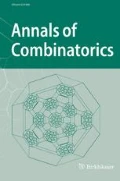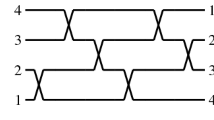Abstract
We continue our study of a new boundedness condition for affine permutations, motivated by the fruitful concept of periodic boundary conditions in statistical physics. We focus on bounded affine permutations of size N that avoid the monotone decreasing pattern of fixed size m. We prove that the number of such permutations is asymptotically equal to \((m-1)^{2N} N^{(m-2)/2}\) times an explicit constant as \(N\rightarrow \infty \). For instance, the number of bounded affine permutations of size N that avoid 321 is asymptotically equal to \(4^N (N/4\pi )^{1/2}\). We also prove a permuton-like result for the scaling limit of random permutations from this class, showing that the plot of a typical bounded affine permutation avoiding \(m\cdots 1\) looks like \(m-1\) random lines of slope 1 whose y intercepts sum to 0.











Similar content being viewed by others
Availability of data and material
Not applicable.
Notes
Proportional to one-dimensional Lebesgue measure.
References
D. André, Mémoire sur les combinaisons régulières et leurs applications, Ann. Sci. Éc. Norm. Supér. (2) 5 (1876), 155–198.
R. Arratia, On the Stanley–Wilf conjecture for the number of permutations avoiding a given pattern, Electron. J. Combin. 6 (1999), no. 1, N1.
F. Bassino, M. Bouvel, V. Féray, L. Gerin, M. Maazoun, and A. Pierrot, Universal limits of substitution-closed permutation classes, J. Eur. Math. Soc. 22 (2020), 3565–3639.
D. Bevan, Permutation patterns: basic definitions and notation, arXiv:1506.06673 [math.CO] (2015).
S. Billey and A. Crites, Pattern characterization of rationally smooth affine Schubert varieties of type \(A\), J. Algebra 361 (2012), 107–133.
A. Björner and F. Brenti, Combinatorics of Coxeter Groups, Grad. Texts in Math. 231, Springer, New York, 2005.
M. Bóna, Combinatorics of Permutations, Chapman and Hall/CRC, Boca Raton, 2004.
Miklós Bóna, The absence of a pattern and the occurrences of another, Discrete Math. Theor. Comput. Sci. 12 (2010), 89–102.
J. Borga, M. Bouvel, V. Féray, and B. Stufler, A decorated tree approach to random permutations in substitution-closed classes, Electron. J. Probab. 25 (2020), 1–52.
J. Borga and M. Maazoun, Scaling and local limits of Baxter permutations through coalescent-walk process, arXiv:2003.09086 [math.PR] (2020).
F. Borga and E. Slivken, Square permutations are typically rectangular, Ann. Appl. Probab. 30 (2020), 2196–2233.
C. C. S. Caiado and P. N. Rathie, Polynomial coefficients and distribution of the sum of discrete uniform variables, Eighth Annual Conference of the Society for Special Functions and Their Applications, Pala, India, Society for Special Functions and Their Applications, 2007.
M.-F. Chen, From Markov Chains to Non-Equilibrium Particle Systems, World Scientific, Singapore, 1992.
S.-E. Cheng, S.-P. Eu, and T.-S. Fu, Area of Catalan paths on a checkerboard, European J. Combin. 28 (2007), 1331–1344.
N. Clisby, Endless self-avoiding walks, J. Phys. A: Math. Theor. 46 (2013), 235001, 32 pp.
A. Crites, Enumerating pattern avoidance for affine permutations, Electron. J. Combin. 17 (2010), #R127.
S. Elizalde, Fixed points and excedances in restricted permutations, Electron. J. Combin. 18 (2) (2012), #P29.
W. Feller, An Introduction to Probability Theory and Its Applications, Vol. I (Third Edition), Wiley, New York, 1968.
R. Glebov, A. Grzesik, T. Klimošová, and D. Král, Finitely forcible graphons and permutons, J. Combin. Theor. Ser. B 110 (2015), 112–135.
W. Hoeffding, Probability inequalities for sums of bounded random variables, J. Amer. Statist. Assoc. 58 (1963), 13–30.
C. Hoppen, Y. Kohoyakawa, C. G. Moreira, B. Ráth, and R. M. Sampaio, Limits of permutation sequences, J. Comb. Theory B 103 (2013), 93–113.
S. Janson, Patterns in random permutations avoiding the pattern \(132\), Combin. Probab. Comput. 26 (2017), 24–51.
S. Janson, Patterns in random permutations avoiding the pattern \(321\), Random Structures Algorithms 55 (2019), 249–270.
N. L. Johnson, S. Kotz, and N. Balakrishnan, Continuous Univariate Distributions, Vol. 2, Second Edition, Wiley, New York, 1995.
R. Kenyon, D. Král’, C. Radin, and P. Winkler, Permutations with fixed pattern densities, Random Struct. Alg. 56 (2020), 220–250. https://doi.org/10.1002/rsa.20882
A. Knutson, T. Lam, and D. E. Speyer, Positroid varieties: juggling and geometry, Compos. Math. 149 (2013), 1710–1752.
D. A. Levin, Y. Peres, and E. L. Wilmer, Markov Chains and Mixing Times, American Mathematical Society, Providence, 2009.
N. Madras and L. Pehlivan, Large deviations for permutations avoiding monotone patterns, Electron. J. Combin. 23 (2016), #P4.36.
N. Madras and J. M. Troyka, Bounded affine permutations I. Pattern avoidance and enumeration, Discrete Math. Theor. Comput. Sci. 22 (2) (2021), #1.
A. Marcus and G. Tardos, Excluded permutation matrices and the Stanley–Wilf conjecture, J. Combin. Theor. Ser. A 107 (2004), 153–160.
C. B. Presutti and W. R. Stromquist, Packing rates of measures and a conjecture for the packing density of 2413, Lond. Math. Soc. Lecture Notes 376 (2010), 3–40.
A. Regev, Asymptotic values for degrees associated with strips of Young diagrams, Adv. Math. 41 (1981), 115–136.
L. B. Richmond and J. Shallit, Counting abelian squares, Electron. J. Combin. 16 (2009), #R72.
V. Vatter, Permutation classes, Handbook of Enumerative Combinatorics, Discrete Math. Appl. (Boca Raton), CRC Press, Boca Raton, FL, 2015.
Acknowledgements
We are grateful to Tom Salisbury for a helpful discussion about random measures, and to the anonymous referees for helpful comments.
Funding
The research was pursued as part of a Discovery Grant to N. Madras from NSERC Canada.
Author information
Authors and Affiliations
Corresponding author
Ethics declarations
Conflict of interest
None.
Code availability
Not applicable.
Additional information
Communicated by David Bevan.
Publisher's Note
Springer Nature remains neutral with regard to jurisdictional claims in published maps and institutional affiliations.
N. Madras was supported in part by a Discovery Grant from NSERC Canada, and by a Minor Research Grant from the Faculty of Science at York University.
Rights and permissions
About this article
Cite this article
Madras, N., Troyka, J.M. Bounded Affine Permutations II. Avoidance of Decreasing Patterns. Ann. Comb. 25, 1007–1048 (2021). https://doi.org/10.1007/s00026-021-00553-4
Received:
Accepted:
Published:
Issue Date:
DOI: https://doi.org/10.1007/s00026-021-00553-4



